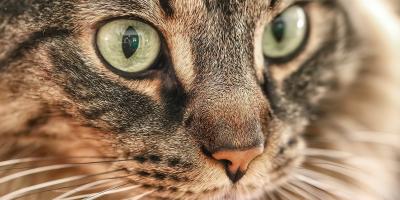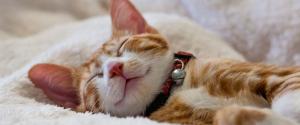
Vision des chats: que voient-ils exactement?

La façon dont les chats voient le monde: comprendre la vision féline
Avez-vous déjà plongé votre regard dans celui de votre chat, vous demandant ce qu’il voit? En raison de leur capacité à se déplacer dans l’obscurité presque totale et de leur perception unique des couleurs, la vision des chats est un sujet fascinant qui continue d’intriguer à la fois les amoureux des animaux familiers et les scientifiques. Bien que le mythe selon lequel les chats voient en noir et blanc persiste, des études ont révélé plusieurs faits sur la façon dont les chats interprètent le monde qui les entoure.
Anatomie de l’œil d’un chat
Bien que l’œil du chat ressemble à celui de l’humain au premier coup d’œil, il comprend plusieurs caractéristiques spécialisées qui améliorent sa capacité à voir lorsque la luminosité est faible et qui lui permettent de détecter les mouvements.
Voici un aperçu des principaux composants:
- Cornée: Couche extérieure transparente, qui protège l’œil et aide à concentrer la lumière entrante sur la rétine.
- Iris: Partie colorée de l’œil, qui ajuste la taille de la pupille pour contrôler la quantité de lumière qui pénètre.
- Pupille: Verticale, en forme de fente, qui se dilate beaucoup lorsque la luminosité est faible et qui se contracte dans des conditions lumineuses.
- Cristallin: Situé derrière l’iris, il s’ajuste pour focaliser la lumière sur la rétine.
- Rétine: Couche sensible à la lumière située à l’arrière de l’œil et qui contient des bâtonnets et des cônes. Les yeux des chats renferment beaucoup plus de bâtonnets que ceux des humains; leur vision nocturne et leur détection des mouvements sont donc supérieures aux nôtres.
- Tapetum Lucidum: Couche réfléchissante située derrière la rétine qui améliore la vision lorsque la luminosité est faible en faisant rebondir la lumière à travers la rétine. C’est d’ailleurs cette dernière qui fait briller les yeux d’un chat dans le noir.
- Membrane nictitante: Couche translucide, aussi appelée troisième paupière, qui aide à protéger l’œil contre les débris et les blessures.
Ces composantes travaillent de concert pour donner aux chats leur vision nocturne caractéristique et leur sensibilité accrue aux mouvements.
Comparaison de la vision féline à la vision humaine
Bien que les chats et les humains partagent certains traits visuels, il y a plusieurs différences clés dans leur façon de percevoir le monde:
- Sensibilité à la lumière: Grâce à leurs nombreux bâtonnets et à leur tapetum lucidum, les chats peuvent voir lorsque le niveau de luminosité est de six à huit fois plus faible que celui où l’humain cesse de voir.
- Champ de vision: Les chats profitent d’un champ de vision plus large, soit d’environ 200 degrés, alors que le nôtre est de 180 degrés. Ils ont donc une meilleure vision périphérique.
- Détection des mouvements: Bien que les humains soient meilleurs pour repérer de petits détails dans la lumière vive, les chats excellent à repérer les mouvements, surtout dans les conditions où l’éclairage est faible.
- Forme de la pupille: Les pupilles verticales des chats leur permettent de s’adapter rapidement lors des changements de luminosité et les aident à percevoir la profondeur pendant la chasse.
- Perception des couleurs: Les chats ne sont pas complètement daltoniens, mais ils voient une gamme limitée de couleurs. Ils perçoivent les bleus et les verts plus clairement que les rouges et les roses, qui semblent grisâtres ou atténués.
Quelles couleurs les chats peuvent-ils voir?
Les chats voient le monde dans une palette de couleurs plus atténuées que les humains. Leur vision est semblable à celle d’une personne atteinte de daltonisme rouge-vert. Bien qu’ils puissent distinguer certaines nuances de bleu et de vert, ils éprouvent plus de difficulté à percevoir les rouges et les roses.
Par exemple:
- Bleu: ils voient cette couleur vive
- Vert: ils voient cette couleur, mais moins vive que celle perçue par les humains.
- Rouge/rose: ils perçoivent probablement ces couleurs comme du gris ou du brun.
À quel point la vision d’un chat est-elle nette?
Les chats sont considérés comme myopes. Alors que les humains ont généralement une vision de 20/20, l’acuité visuelle d’un chat varie de 20/100 à 20/200. Cela signifie que pour voir un même objet aussi clairement, l’humain devra être situé à une distance de 100 pieds, et le chat devra être situé à une distance de 20 pieds.
Malgré cela, les chats excellent à détecter les moindres gestes, ce qui est un atout crucial pour la chasse.
Les chats voient-ils mieux que nous la nuit?
Tout à fait. Les chats sont des animaux crépusculaires; cela signifie qu’ils sont plus actifs à l’aube et au crépuscule. Les capacités de leurs yeux s’accroissent des conditions où la luminosité est faible. Grâce à leurs rétines dominées par les bâtonnets et leur tapetum lucidum réfléchissant, la vision des chats est jusqu’à sept fois meilleure que celle des humains dans l’obscurité.
Les chats sont-ils myopes ou hypermétropes?
Il y a un débat continu à ce sujet entre les experts. Certains croient que les chats sont légèrement myopes en raison de leur capacité limitée à adapter la forme de leurs cristallins. D’autres affirment qu’ils sont emmétropes, ce qui signifie que leur vision est normale en fonctions de leurs besoins. La plupart s’entendent pour dire que les chats sont bien adaptés à leur environnement, car leur vision est optimisée pour détecter les mouvements et se déplacer dans des conditions où la luminosité est faible.
Voici comment déterminer si votre chat a des troubles de la vision
En tant que propriétaire d’animal familier, il est important que vous surveilliez la santé oculaire de votre chat. Les signes de troubles de la vision potentiels comprennent:
- Voile ou décoloration dans les yeux
- Larmoiement ou écoulement excessifs
- Strabisme ou sensibilité à la lumière
- Paupières enflées ou rouges
- L’animal se heurte à des meubles ou à des murs
- Troisième paupière visible (membrane nictitante)
- Taille des pupilles inégale
Si vous remarquez l’un de ces symptômes, consultez votre vétérinaire rapidement. Une détection précoce peut contribuer à prévenir des affections plus graves.
Voici comment les vétérinaires évaluent la vision des chats
Les vétérinaires peuvent utiliser plusieurs méthodes pour évaluer la vue de votre chat:
- Observer comment votre chat se déplace dans une pièce
- Vérifier les réflexes de clignement des yeux
- Utiliser une lumière pour tester la réaction de la pupille
- Mesurer la pression oculaire à l’aide d’un tonomètre
Ces tests aident à déterminer si la vision de votre chat se situe dans une plage saine ou si un traitement supplémentaire est nécessaire.
Les conclusions de Purina Canada
Même si les chats ne voient pas le monde dans les mêmes couleurs éclatantes que nous, leur vision est parfaitement adaptée à leurs besoins de chasseurs agiles et d’amateurs de crépuscule. Comprendre comment votre chat voit peut vous aider à mieux prendre soin de sa santé et à enrichir son environnement.
Pour obtenir des conseils d’experts sur le comportement et le bien-être des chats, consultez nos articles Comprendre les chats.
Articles connexes


